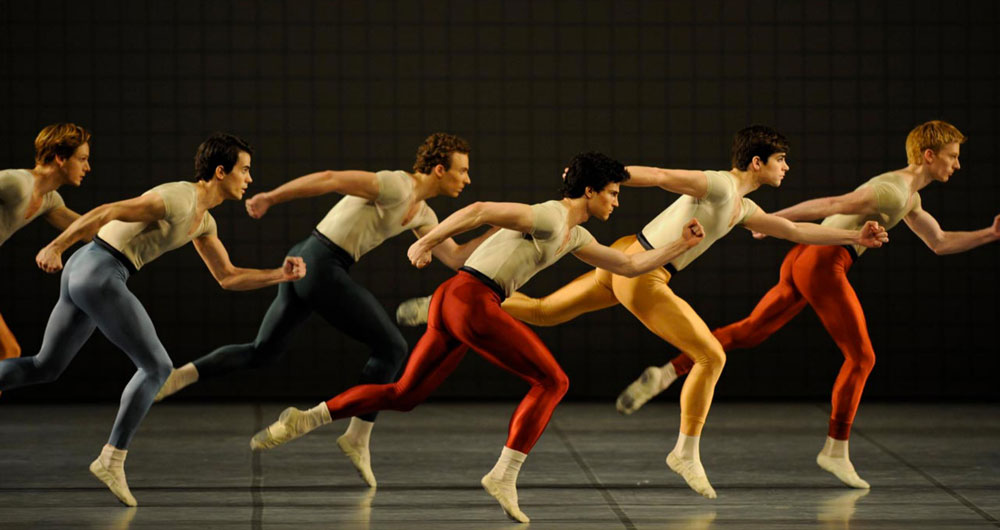
Features writer Catherine Stoehr summarizes and reviews San Francisco Ballet’s Program 8. In addition to being an Outlook staffer, Stoehr trains in ballet.
The repetitive pounding of feet. Purposeful strides. Blank faces of those that move with a single intention only. These are things you might expect to see on a busy urban street, not on a classical ballet stage. But San Francisco Ballet’s Program 8 stripped away much of the classical ideal, highlighted Glass Pieces by Jerome Robbins, and took its audience to the era of post-neoclassical and postmodern era of dance. Program 8 ran for the first two weekends in May 2014.
The first piece, Agon, was choreographed by George Balanchine—one of the most prominent neoclassical choreographers. Neoclassical ballet is a detour from the historic classical technique and incorporates many alterations of classical movements to make them more free and bold. Agon‘s simple costumes (black leotards and tights) and lack of any scenery force the audience to focus completely on the dancers. In this ballet, the lines of a dancer’s body is very important.
After the brief introductory dance that gives a glimpse of all the dancers who will be on stage, the show moved into the first Pas de Trois. In this case it was one male dancer, Gennadi Nedvigin, with female dancers Grace Shibley and Jennifer Stahl. This type of pairing with uneven numbers of men and women was a part of Balanchine’s effort to distinguish his ballets from those of the classical style, which were often made up of traditional boy-girl partnership. The one problem with this variation was a particularly convoluted part where the women were on each side of Nevigin and they were holding hands. Then, the dancers crossed through each other and went under their still connected hands in such a way that reminded me of a poorly executed playground game. It seemed that the triplet was not in perfect sync and there were awkward moments during which they would almost get stuck. This was a contrast from the rest of the scene, which was elegantly executed.
One Pas de Deux within Agon particularly stood out. Yuan Yuan Tan and Davit Karapetyan did an amazing job in this passionate dance. Even though it was an abstract dance, a clear story of a tumultuous relationship shined through it. There was a constant push-pull where each dancer tried to escape but inevitably came back. The choreography showed the dancers almost never apart, always touching in some way even as one seemed to be trying to break the bonds. Tan and Karepetyan both performed well in this physically and emotionally demanding piece.
Next was the Brahms-Schoenberg Quartet, also choreographed by George Balanchine. This ballet consists of four completely separate movements, connected with the common music score. While it is also a Balanchine ballet, this one is much closer to its classical roots with more classical costumes and less revolutionary choreography. The dancers were clothed in deep maroon dresses decorated with gold embroidery. Lorena Feijoo and Jaime Garcia Castilla took on royal personae with their crown headpieces, and they played the parts well. Feijoo was simply elegant with her use of heads and arms, adding to her regal quality. Simone Messmer had a significant soloist role and her perpetual smile was a wonderful addition and highlighted her joy of dancing. In contrast, the second movement had a dreamlike quality. The fourth and final movement was an upbeat, folk-like dance with roots in the character dance style of old Russia. Both the peasant style costumes and the choreography—which was heavy on the foot stomping—was a welcome change of pace. Sofiane Sylve’s powerful movements, stunning turns, and boisterous stage presence fit the dance well and was a great casting choice by San Francisco Ballet.
The final piece, Glass Pieces, was the highlight of the program. The music by Philip Glass was powerful yet completely simplistic. The first movement, Rubric, began with almost the entire ensemble striding on stage. Set to the frantic music of Glass, each followed their own specific path and walked exactly on the music with clockwork accuracy. All the dancers had lifeless expressions on their faces, and the tone reminded the audience of the sort of urban urgency by which the modern world is driven. Then, a couple broke out of the wings wearing matching solid colored unitards, executing their own dance among the drone-like dancers. Then, two more couples appeared, making a total of three couples on stage. The couples appeared to be fighting off the impending masses.
The second movement began with an empty stage. As the repetitive notes of the strings play, a silhouetted figure appeared at the back of stage. More dancers followed until there was a line of dancers slowly chugging their way across the stage, changing spots, freezing at any given moment, in perfect sync. As a woodwind began to play high melancholy notes, Kristina Lind and Tiit Helimets come out bathed in spotlight, a stark contrast to the dark assembly line in the back. The piece was very moving with the dancers’ pristine lines and the impassioned music.
This collection of pieces put together by San Francisco Ballet do a wonderful job in giving the audience a taste of the post-classical ballet era. Overall, Agon and Brahms-Schoenberg were well executed and enjoyable, but Glass Pieces was on another level altogether. The combination of dramatic music and pure movement made this a very successful ballet.






Catherine Stoehr